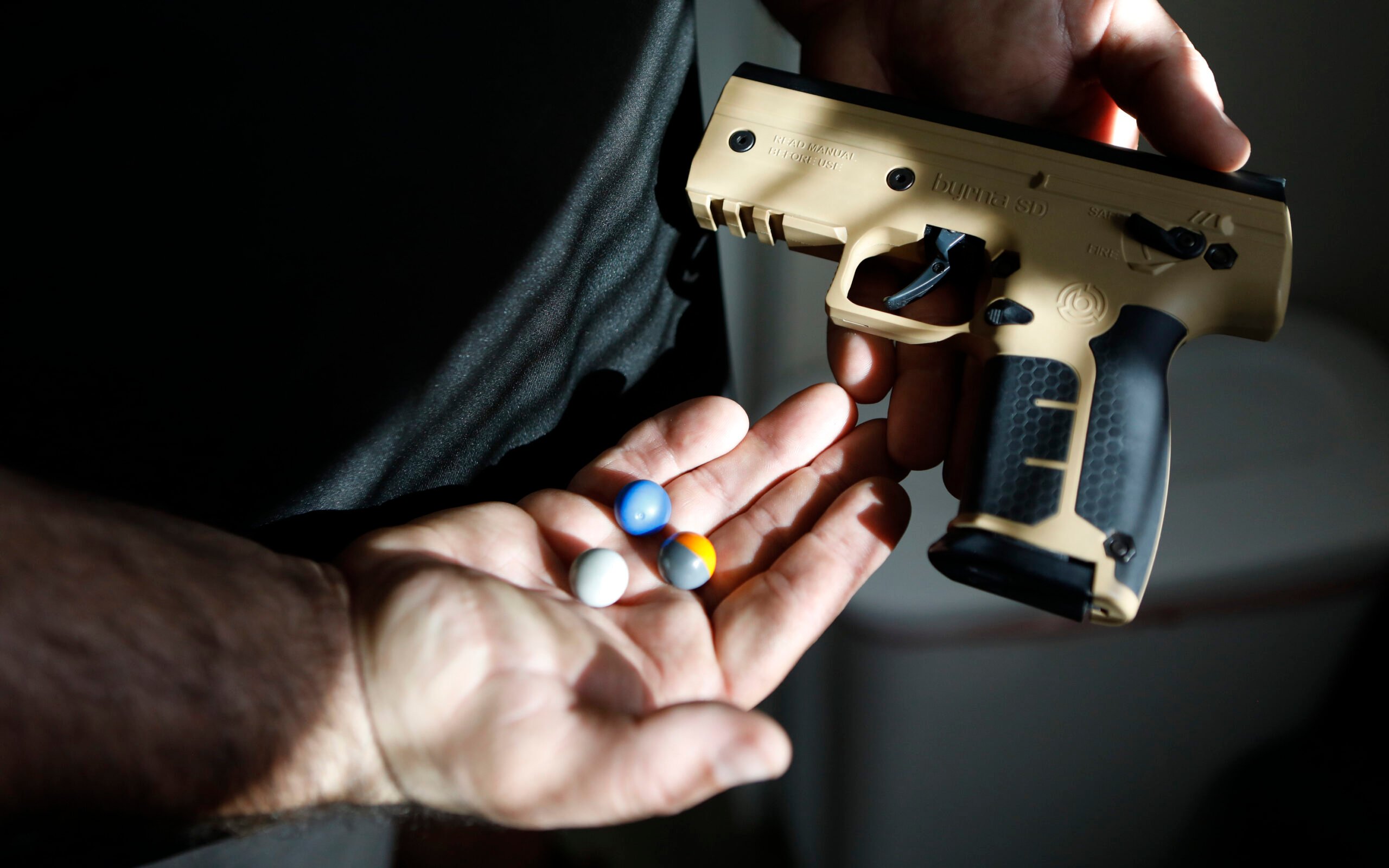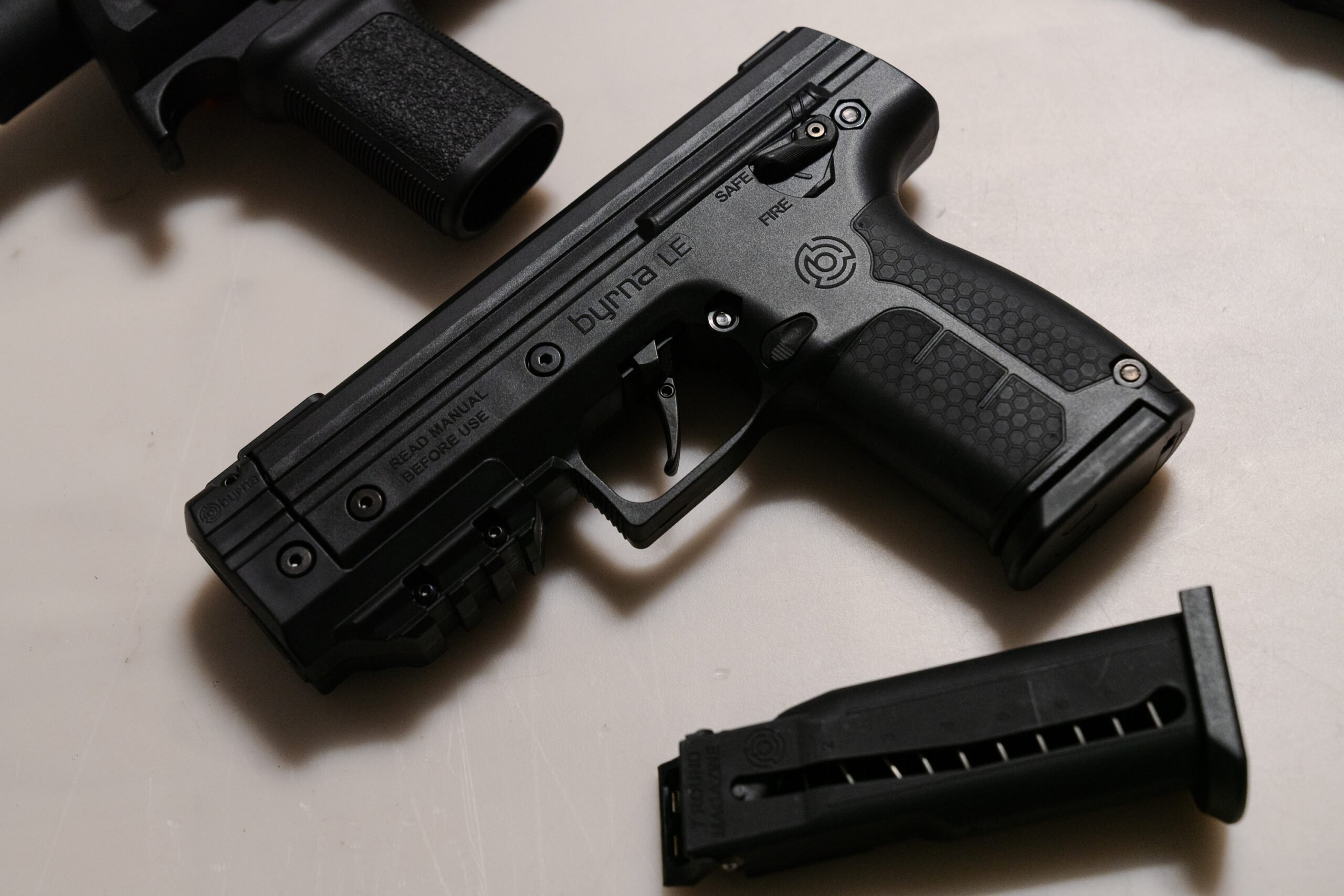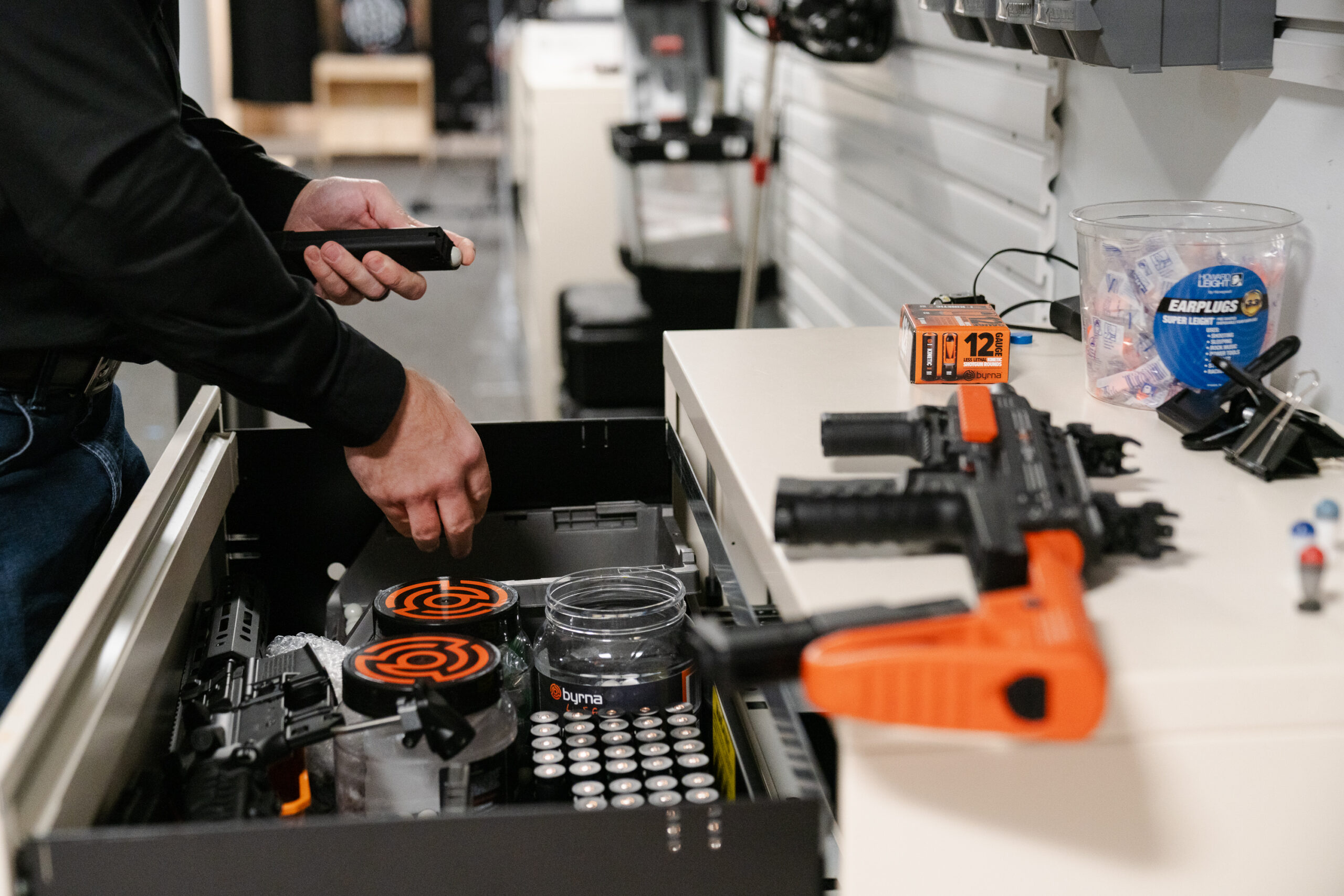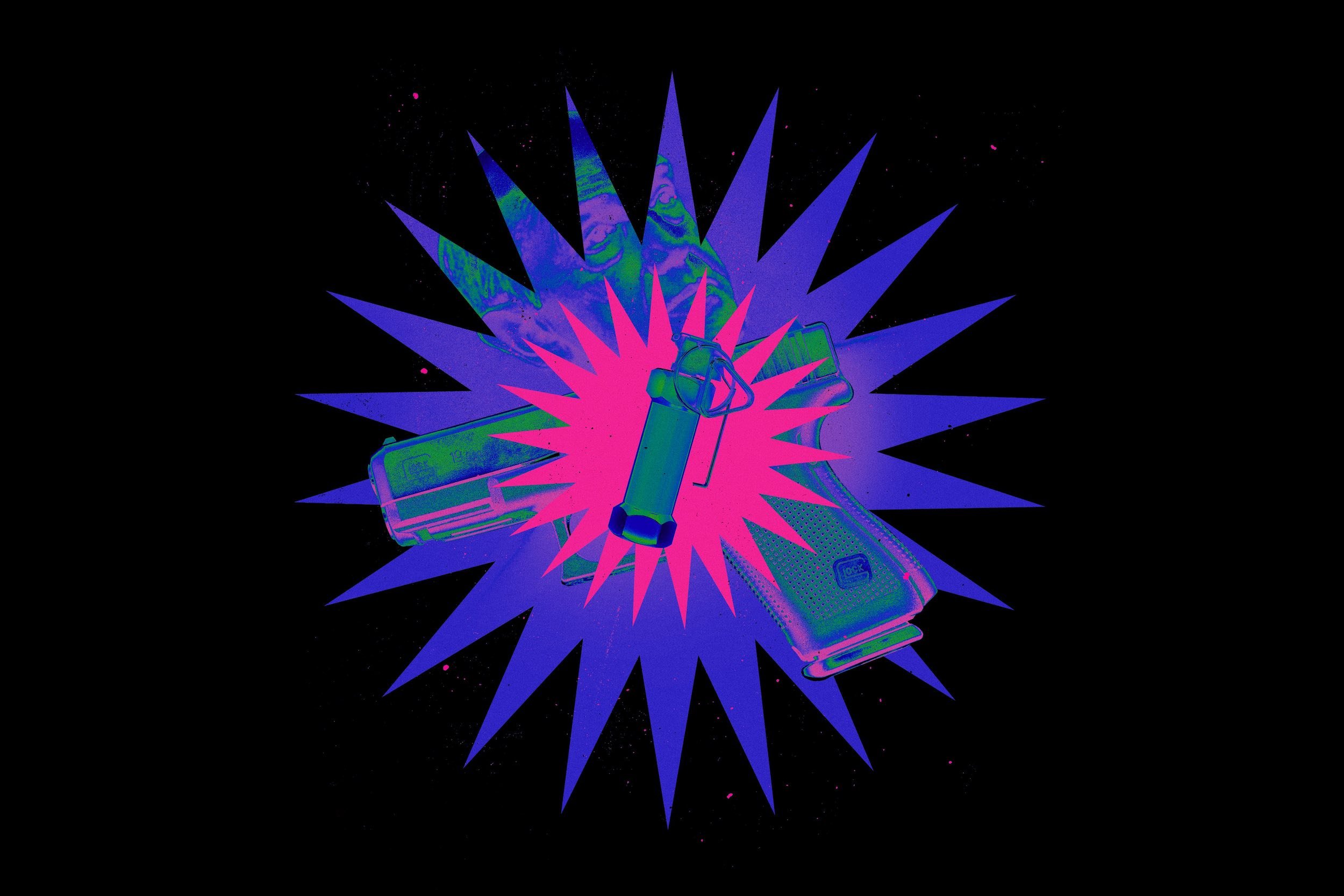The crackle of handgun fire sounded like static from a dead channel and beneath it rumbled the heavy concussion of rifles as people picked off targets up to a half mile away. The sky looked ominous, but the thousands of gun enthusiasts bustled about with the enterprise of ants at a picnic.
It was the opening of Shot Show 2023, the biggest firearm trade show in the world, which each January draws tens of thousands of manufacturers, dealers, and hobbyists to Las Vegas. To kick off the event, many attendees drive out into the desert for “range day,” where they test-fire the latest merchandise into the rocky red hillside. The atmosphere is typically festive, but this year the gun industry had even more cause to celebrate: Americans have purchased more than 67 million guns since 2020, the most rapid citizen armament ever recorded.
At the shooting lane of Byrna Technologies, Inc., there was no sound of gunfire. One of a handful of companies at the event that sells “less lethal” weapons, Byrna was showcasing what seemed like a paradox: a gun built to deter and disorient, but not to kill.
The devices borrow the form of traditional firearms but instead of metal bullets they launch .68-caliber plastic spheres, which are propelled by compressed gas rather than exploding gunpowder. Lighter than traditional ammunition and moving at lower speeds, these projectiles produce an excruciating impact but do not have the kinetic energy to penetrate skin. Users can also opt for ammo loaded with tear gas or oleoresin capsicum, an extract of hot peppers, which can induce nausea, difficulty breathing, and a terrible burning in the throat, lungs, and eyes. “Devastating stopping power,” the company’s ads promise, “without the lethal consequences.”
Byrna’s founder and chief executive Bryan Ganz circled like an attentive host, his leather jacket and boots marking a contrast with the crowd, who were attired mostly in camouflage and fleece. His company is minuscule when compared to the country’s major gunmakers, but it reports having sold over 300,000 handheld and shoulder-fired weapons since 2019.
And while Ganz appeals to Americans’ seemingly bottomless appetite for firearms, he and his company seek to sidestep debates that have ensnared the gun industry. That morning while driving to the range with his team, we had passed a line of identical yard signs that gun control advocates had planted in the median. Spaced about 10 feet apart and running for more than a mile, each read: Guns are the #1 killer of kids and teens in America. One of the executives quipped, “Not Byrna!”
In fact, Ganz sees the messy politics of guns as a business opportunity. “There’s a fraying of the social fabric around the world. It’s a little scary. On the other hand, people are truly fed up with gun violence,” he told me. “Both are tailwinds for Byrna.”
But these tailwinds could also present a risk. Byrna’s products scramble the very concept of a gun in a country where the object is larded with meaning. And between America’s polarized tribes of gun lovers and gun haters, there is very little room for error.

Less lethal weapons have been around for years but before Byrna, no one had made a concerted effort to popularize them with the general public. Axon produces the most renowned less-lethal weapon, the Taser, but has historically marketed almost exclusively to law enforcement. Devices made by other companies, like Pepperball Technologies, are too big and cumbersome for everyday use and have never had a broad appeal.
There are peculiar challenges to marketing weapons. Many media companies won’t accept advertisements for products that even look like guns. And although traditional gunmakers would be well-positioned to bring a less lethal weapon to market, those that have explored it have reversed course. Beretta and FN Herstal both developed less lethal shotguns, the LTLX-7000 and the FN 303, but neither brought the devices to the civilian market.
Eric Bratten, who helped found the less lethal weapons company Mission Less Lethal and has worked at others, said the gunmakers were afraid of undermining their existing business. “The feedback they got was: Your core market of hardcore gun people will revolt, and you will lose.”
It’s easy to see why gun owners might perceive a less lethal offering as an admission that traditional guns are problematic. But over the last century, the primary use of firearms has changed. Lethality was essential when they were mainly tools for hunting animals or national defense, but now nearly three-quarters of people who own guns say they do so for self-protection against other humans. In 2000, only 30 percent of gun sales were handguns; they make up 60 percent of gun sales today.
Axon’s founder, Rick Smith, contends that the basic function of a firearm is now out of step with its purpose: People buy guns for self-defense not because they are lethal but because they can reliably stop people in their tracks. “This idea of shooting holes in people with bullets,” he observed, is an incredibly blunt way of bending them to your will.
In other words, what if lethality — the defining characteristic of a firearm — is not actually what many gun buyers are shopping for?
Ganz, a tycoon with an adventurous streak, is an outsider to the firearm industry. Although he describes himself as “a gun-toting, whiskey-drinking, truck-driving liberal,” he is more often behind the wheel of his Audi R8 supercar. In the early 1980s, while studying at Columbia Law School, he and some friends started a financial management firm. Later he helped grow a family tire company into a global business before selling it to private equity.
He became interested in less lethal weapons in 2018, while he was helping turn around an obscure Canadian company, Security Devices International, that made a bulky 40mm round mostly used by SWAT teams and penal institutions. You needed a grenade launcher with a rifled barrel to fire it, requiring a special license the mass public could never be expected to obtain.
While at Shot Show hawking the ammo, Ganz got introduced to a young South African inventor named André Buys. Buys was a paintball enthusiast who had grown frustrated with the performance of the sport’s launchers and had developed a projectile with a patented tail-fin that could be fired accurately from a smooth-bore barrel. He demonstrated it at Shot Show by hitting a 4-inch post from about 200 feet away.
Ganz said it was “like the light bulb went off.” A widower with three adult daughters, he had never been satisfied with the pepper spray he’d given them, since it’s effective only once an assailant is within arm’s reach. Civilian models of Tasers have a range of just 15 feet.
Located in a wooded industrial park north of Boston, Byrna’s headquarters still has the feel of a startup, with malapportioned and mostly empty offices upstairs and a research lab and firing range in the basement, below grade to keep the sound of discharging weapons from bothering the neighbors.
Referencing a monitor that displayed a model of Byrna’s first handheld weapon, Buys explained the complexities of its interior. He had previously worked for the optical company Carl Zeiss Optronics, where he designed products that required precise engineering such as submarine periscopes, and he argued that Byrna’s products were more technologically sophisticated than traditional firearms. Whereas a typical Glock handgun has 34 parts, Byrna’s launcher has 115, and once it is armed with a canister of compressed carbon dioxide, it must contain the gas at a pressure of 800 pounds per square inch.
But if inventing the weapon was a challenge, that paled to the difficulties of explaining it to customers. What do you call a gun that’s not a gun? The company, which had codenamed its first handheld weapon “Stingray” during its development, opted for an anagram of Ganz’s first name when they began taking orders in February 2019. The company rented billboards mysteriously proclaiming “the un-gun,” and would variously describe it as a “device,” “launcher,” and “non-lethal weapon.” Its Facebook feed pitched it to parents sending their daughters off to college (“Shouldn’t she be able to defend herself?”) and to people who drive for a living (“Are you or a loved one a trucker?”).
To convince skeptical customers of the weapons’ deterrent effect, Ganz and his marking director volunteered their bodies as targets: with a camera running, another staff member shot each of them with a Byrna, then posted the videos online. Upon taking a shot to the leg, Ganz swore and hopped in pain, later displaying a raised welt. Despite their efforts, Byrna finished the year with less than $1 million in sales.
In early 2020, the pandemic forced the company to briefly close its production facility. But after the murder of George Floyd on May 25, when some American cities erupted in civil unrest, gun sales spiked — Americans bought 1.6 million handguns that June, more than any month before or since — and Byrna’s sales also began to rise.
Earlier that year, a Byrna investor who sometimes golfed with Sean Hannity had shown the Fox News commentator the weapon, and Hannity had invited Ganz out to his home in Long Island to demonstrate it. On his June 9 broadcast, following a segment about “the Left’s plan to dismantle the police,” Hannity ran a video of the Byrna handgun and, underscoring that he had no financial interest, said he had purchased a number of them. “This is an alternative. It won’t kill people: non-lethal defense.”
Byrna’s website received more visitors that evening than in the entire previous month, the company said, and sold $2 million in merchandise before midnight. By the following week, Byrna’s stock had doubled in value. Over the next three months, struggling to scale up production to meet demand, the backlog of unfulfilled orders grew to more than $10 million.
The inexperience of the company showed. Byrna was converting a distribution center in Ft. Wayne, Indiana into a production facility but could only bring in cash as fast as it could ship orders out. “I was worried about making payroll,” recalled chief financial officer David North.
Customers who were waiting months for their deliveries began to get irate. “You shouldn’t be taking orders for $100s of dollars if your product is on back order,” one commented on Facebook. Another, who said she had been waiting three weeks longer than expected, wrote: “Hope your gun is a hell of a lot better than your customer service!”
To top it off, in February 2021 the company discovered that a wire in its weapons was too small and under specific conditions, they could fire even with the safety on. Several hundred Byrnas had to be recalled and repaired.
Gradually, Byrna caught up with its sales. In August 2021 its weapons were available on Amazon, where ads read, “Designed to defend lives, not take them.” The marketing also leaned into the fact the devices aren’t regulated like guns: “No permits or background checks required and no waiting periods.”
As tens of thousands of people began to experiment with the weapons, a nascent culture took hold around them. The company established a Facebook group for its customers, “Byrna Nation,” but the most popular, “Byrna Owner’s Group,” was started in 2021 by Charles Woods, an auto mechanic in New Hampshire.
Woods grew up with guns but now, with two young kids of his own, he had reservations about keeping firearms at home. An early adopter of Byrna’s first handheld weapon but unsatisfied with its power, he designed an adapter to affix a 12-gram cylinder of carbon dioxide instead of the original 8-gram cylinder. He started the Facebook group in part to market his gadget and other less lethal launchers, but the online conversation, lightly moderated, took on a life of its own.
Byrna aficionados posted pictures of their own customizations. Others, shopping for their first weapon, posed questions. The group rapidly reached the maximum 10,000 members Facebook allows, so Woods began a second group that now has over 2,000 members.
You don’t see this kind of community formed around Tasers, said Axon founder Rick Smith, since they are fairly utilitarian and can’t be safely customized. (Lately, Axon had nonetheless re-evaluated the consumer market for its self-defense products, and seeing a much larger business opportunity, was promoting a new Taser for non law-enforcement, the Bolt 2.) Smith credited Byrna with tapping into aspects of gun ownership that are recreational and social. “Candidly, owning a Taser is just not a lot of fun.”
Byrna’s customers also began sharing stories on Facebook about how they were using them, including for self-defense.
Frank Leto was leaving his apartment in Temple Terrace, Florida, on a Tuesday afternoon when he encountered a man dragging a woman down the concrete stairs. “I drew my Byrna less lethal,” he wrote in a statement to police. “Held suspect at gunpoint till officers arrived.” Leto was comfortable with guns but told me had never carried in public because of their lethality. “I can get behind this because it’s not gonna kill somebody,” he said of the Byrna.

Leto said his wife, a schoolteacher, had been skeptical about the weapon “because of the kids,” but after the incident “she was like, ‘Alright, now I want one.’” He was thinking about buying her a Byrna for Christmas.
In some cases, the presence of a Byrna seemed to inflame tensions. In Pennsylvania, 19-year-old Patrick Sweeney was in a car with his mom when they got into an altercation with another driver, who screamed at them and allegedly attempted to reach into their vehicle. Sweeney, who was on probation for brandishing a handgun the previous year, drew a Byrna and pointed it at the other man, who retrieved his own handgun and pointed it at Sweeney’s mom. A police officer ultimately broke up the argument.
Sweeney, who works as a security guard, says he now carries a Byrna 24/7. “I still have a handgun in my safe in my house and I’ve still got my rifle ready at any time [at home], but Byrna will always be my first resort.”
Other handgun owners who have adopted the Byrna said that knowing it was less lethal made them less hesitant to draw. Gary Ray, a 51-year-old in Anchorage, Alaska, said he fired his Byrna at a “mama moose” that was chasing his dog; after three hits, she veered back into the forest. He also said he’d shot two people, both of whom he described as panhandlers who had gotten aggressive. He didn’t report either incident to police: “Call 311, let them know what happened, and you’re good to go.”
Less lethal weapons aren’t without risk. In May 2022, a man in a heated argument on a street corner in the South Bronx was shot to death by plainclothes police after they say he fired a Byrna at them. They mistook it for a handgun.
Still, Ganz maintains that the devices do much more good than harm. Alluding to a string of incidents in which a homeowner shot a family member or passersby after confusing them for an intruder, he argued that, had they employed less lethal weapons instead, everyone would have walked away. “Every time you use your less lethal firearm instead of your lethal firearm, you’re potentially saving a life.”
Public health scientists aren’t so sure, including David Hemenway, who directs the Harvard Injury Control Research Center. He reasoned that if would-be handgun buyers opt instead for less lethal weapons, it could prevent suicides, since mere access to a handgun increases a person’s risk of firearm suicide by nine times, according to a recent study. But he said much would depend on whether people replace a lethal weapon or merely incorporate the new device into their arsenal. And Byrna certainly doesn’t market its wares as a replacement for guns — Ganz goes so far as to call the Byrna “a gateway to firearm ownership.”
Nonetheless, making guns less dangerous is an idea Hemenway has long envisioned. One of the first articles he co-authored about gun violence, over 30 years ago, was titled “Phasers on stun: The case for less lethal weapons.” Drawing fanciful inspiration from the energy weapons of “Star Trek,” the authors imagined that bullets could be redesigned with less potential to wound, or replaced with electric darts or tranquilizers. “Since private citizens seem determined to own guns, it is fair to ask whether they can be made safer,” they wrote. Nowadays, this model of “harm reduction” is increasingly used to minimize the ill effects of drugs, alcohol, and sex.
Hemenway’s proposals were pie-in-the-sky, but he said they were grounded in a reality that gun violence prevention efforts must reckon with: Public health’s biggest successes have typically been achieved by redesigning products or altering the physical environment, not by influencing human behavior. That’s because the latter is “just so hard.”

In 2022, Byrna’s growth slowed. The company made $48 million in revenue, up 14 percent from 2021, but far short of Ganz’s projection of $65 million, and Byrna’s stock price slid from nearly $30 in August 2021 to $8 at the beginning of 2023. The plug by Sean Hannity had seemed like a boon, but now the executives found themselves fighting against a narrative that it was all that had propped the company up. “We are confident people shopping for less lethal will buy Byrna,” Ganz told me. “We need more people to shop for less lethal.”
Byrna suffered another setback in March 2023 when Meta and Google abruptly cut the company off from advertising on their platforms. Revenues plummeted by 43 percent in the third quarter, compared to the year before, and Byrna’s stock tumbled beneath $3, although it ticked up slightly after YouTube quietly lifted its ban. Later, Byrna inked a paid endorsement with Hannity and reported its best September on record.
Those ups and downs were still months away at last January’s Shot Show, where 2,500 companies spread their booths across 18 acres, and over 50,000 attendees browsed 13.9 miles of products. There were lubricating elixirs to rub onto your guns and lasers to engrave them and solvents to clean them. There were virtual reality training simulators, patent-pending buttstocks, and pyrotechnic exploding targets; even the state of Wyoming had a booth. And, of course, there were lots and lots of guns.
Like many smaller exhibitors, Byrna had opted for a booth in the basement, although the company had splurged and paid $60,000 for a space at the end of an aisle where they would be more visible. Ganz said he preferred it downstairs with other inventive up-and-coming companies. About 20 spirited staff members hovered around the displays, so it appeared busy even when customers were scarce.
Hoping to make further inroads among gun owners, Byrna unveiled several new products. The company had introduced a new, more powerful launcher that was accurate up to 80 feet, and a less expensive “essential” pistol priced just below $300. The centerpiece was a new line of less lethal ammunition designed to be fired out of traditional 12-gauge shotguns. The rounds resemble regular cartridges, but in flight they break open to reveal fin-tailed projectiles, which the company said could accurately travel 100 feet with a heavy payload of chemical irritant but would not break human skin. A promotional video promised that the ammo was quieter than “your average squeaky dog toy.”
For Americans who already own the 65 million shotguns in circulation, Ganz hoped, this would lower the barrier to entry to less lethal technologies: They need only buy a $40 box of ammunition. A law enforcement website reviewed the projectiles favorably, and Shot Show said they were one of the “most scanned new products” on the event’s mobile app.
Directly across the aisle, the hardcore gun rights advocacy organization Gun Owners of America had a booth. In a break between a series of interviews, senior vice president Erich Pratt said he hadn’t visited Byrna’s display, but he didn’t object to less lethal weapons. “It’s at a minimum a great alternative when a gun is not an option legally,” he said, including for kids. However, “If my life is on the line, I want something that would be lethal,” he added.
Giddy about the state of gun rights, Pratt predicted that future victories in the courts would reinforce Americans’ appetite for armed self-defense. The Supreme Court’s recent Bruen decision was “a game changer,” he said, and at that time 25 states allowed people to carry concealed handguns without any permit. “As we get more and more freedom, more and more people are choosing to exercise their right.” Since then, two more states have followed suit.
Byrna is making a bet that some would-be gun carriers could be satisfied with a weapon that is not deadly. The company is miniaturizing its compact pistol by another 25 percent so it is easier to conceal and more comfortable for people with smaller hands, including women. Ganz also said he’d been talking with a large U.S. gun manufacturer that had tested Byrna’s products and expressed interest in selling the new weapon under its brand.
That partnership could unlock a vast new market, Ganz believes. “When a hundred-million gun owners realize that less lethal is really a thing,” he said, “you’re gonna get millions or tens of millions of people willing to carry a less lethal firearm.” But Byrna won’t be assured of the agreement until the design is completed.
Amid the sea of gun sellers and ardent hobbyists, it seemed improbable that any single company could change the trajectory of American gun culture. Yet, upstairs on the main floor of the Venetian Expo, with a booth easily 10 times the size of Byrna’s, was a company that had. Glock’s simple tagline — “Perfection” — glowed in white from a two-story, matte black installation that spread over several thousand square feet.
James Cassells, who manages Glock’s sales in Canada, showed off a Glock 19, the company’s most popular model. Cassells hadn’t heard of Byrna, but said selling a quarter-million launchers in four years was “a pretty good number.” The contrast went unstated: In 2021 alone, Glock sold 2.3 million firearms.
Gaston Glock was a middle-aged curtain-rod manufacturer when his company began making guns over 40 years ago. Cassells explained how Glock took a risk by making guns from polymer, which is lightweight and can be quickly molded in batches, unlike guns made of steel that must be painstakingly cut. Glock’s revolutionary manufacturing process yielded firearms that were simple, sleek, and durable, utterly disrupting the gun industry.
Another venerable gun company, Heckler & Koch, had actually developed a polymer gun first, Cassells said, but it was unwilling to risk its reputation on the new material. The newcomer had no such hesitation.
“We were the first ones to take it to market, and the rest is history. We never looked back.”




